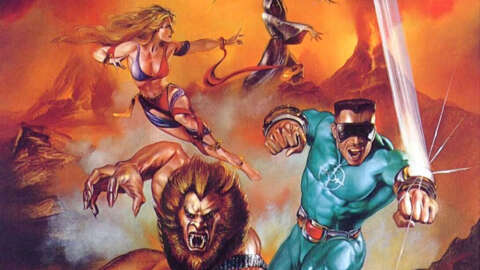2019’s Wargroove turned out to be one of the best tactics games of recent years, thanks in no small part to its great strategy gameplay clearly inspired by Nintendo’s Advance Wars series. Four years and a proper Advance Wars remake later, Wargroove 2 has arrived with much more of everything that made the first game so impressive, even adding an all-new game mode and improved map creation tools. It breaks very little new ground when it comes to its story or the actual tactical combat options, but that’s forgivable since what’s there is just as much fun the second time around. After all, if it ain’t broke, don’t fix it.
Wargroove 2’s single-player campaign takes place a few years after its predecessor and introduces a new faction of feisty fighting rodents called the Faahri, who have come to Aurania to dig up some more magic weapons that should better stay hidden. You’re essentially playing the bad guys this time around, and while there is a little more to it than that, don’t expect the story to be any deeper than it was in the original.
As before, you command an army of disposable units and unique commanders against an enemy faction with access to all the same types of units as you. These units come in different shapes and sizes, from X to Y, each with their own strengths and vulnerabilities versus other unit types – flying units obviously hate archers, for example. Sometimes a mission will ask you to defeat all enemies to win, while other times you need to occupy specific buildings or get to a certain point on the map. And if you lose even one commander, which are unique characters with special abilities, it’s game over.
The maps are a little more interesting than that of the first game – one particularly cool level evokes the excellent Into the Breach as an earthquake gradually breaks away parts of the map and allows you to push enemies into holes. Maps also mix different types of terrain and the buffs or debuffs they provide much more freely, so you need to be even more careful about where your units stand in order to either do maximum damage or defend yourself successfully.
Wargroove 2 splits its campaign mode into three different campaigns instead of just one, with the Faahri campaign being the easiest one. The others focus on either the Heavensong Empire, the Outlaws from Wargroove’s Double Trouble DLC, or a new pirate faction, and both are meant for intermediate players, mostly because the maps are bigger and almost all unit types are available from the start. Even the first few missions in a campaign can take up to an hour of careful planning, making Wargroove 2 into a massive game that can easily take over 50 hours, depending on the difficulty setting you choose.
Splitting up campaigns this way is especially helpful for Wargroove veterans or anyone who doesn’t want to wait until a unit gets unlocked as part of the beginner campaign. If you already know how to play and want to enjoy some naval combat right off the bat, you don’t have to wait for it to be introduced again – simply finish the tutorial prologue and then jump right into the pirate campaign. Telling the story from three different points of view makes it easier to introduce all the factions early as well, but it also means none of the stories truly feels like the “main” campaign – they don’t connect as smoothly as before, but the variety they each bring is still a good tradeoff for their lack of a more cohesive story.
Speaking of pirates – the jolly Captain Nadia and her crew of… intellectually challenged individuals also add a few new units to your roster. Riverboats, for example, are units that can fight only against other naval units, but (as the name suggests) they are able to cross narrow rivers that other boats are simply too big for, while Frogs are a new version of Wargroove’s loyal dog units that can use their tongues to pull friend and foe towards them. None of them revolutionize Wargroove’s gameplay exactly, but they are nice options all the same.
Items are a more substantial addition. In some levels, you will have to do without a way to spawn new units, which would be a far bigger challenge without health potions to top your soldiers off. Inothers, you can turn basic units of your choice into a sort of mini commander, equipping them with a weapon that will make them stronger or give them a special attack. It’s a bit annoying that you have to go into the codex to actually find out what the potions and weapons do, and you might have to try some combinations of items and units to see which fits your needs best through trial and error alone, but these are minor gripes with an otherwise smart inclusion. Actual mini commanders are also a thing – they are powerful units that, unlike the real commanders, don’t appear in the story for more than a level at a time to exist mostly to make things a little more difficult for you.
The biggest gameplay change is probably the new two-tiered Groove system. As before, commanders charge up Groove with every action of their units, eventually letting them unleash a special attack unique to each one. However, now if you wait long enough to use it, each Groove gains a second, much more powerful tier that can make it hit harder, affect a larger area, or last longer. Wargroove 2 is just as challenging as the first game, so the decision of whether to use a Groove immediately or wait is often satisfyingly difficult, especially when some of those Grooves are more worth that wait than others.while other Grooves can take a bit of getting used to, like mouse commander Lytra’s small whirlwind that moves enemies and can knock them into ravines or deep water, which is a bit confusing to use at first because it’s difficult to see where exactly units will end up.
Those looking for an extra challenge can sink their teeth into the all-new Conquest mode, which replaces the previous game’s arcade and puzzle modes. Conquest is an entire game on top of a game: Wargroove reimagined as a roguelike. You start with a commander you can choose yourself and a small army that you take into short skirmishes where all deaths are permanent. Event tiles may give you new units and items, or, if you’re unlucky, lead you straight into the sights of a powerful enemy. Permadeath alone probably wouldn’t be enough to make Conquest feel different from Wargroove’s regular mode, but it’s exciting that you suddenly have no idea what kind of enemies await you from level to level – a significant challenge in a game where so much of the strategy is in exploiting enemy weaknesses. The conquest mode is a fun extra option that is guaranteed to make you a better tactician, and it’s great to see an additional game mode with this much thought put into it.
Wargroove’s map creation tools, a standout feature of the first one that allowed you to make everything from custom maps for solo play and multiplayer down to full campaigns, has also received an upgrade. New symmetry tools make it easier to mirror whole parts of your map horizontally or vertically to allow for faster building, and you can now also use game maps for cutscenes. The latter is a nice idea to fit even more storytelling into both the main game and custom campaigns, but unlike actual cutscenes, it’s annoying that you can’t easily skip these. That means if you have to retry a mission from the beginning, you’ll still end up with plenty of stuff to skip over even if you skip the intro cutscene.








